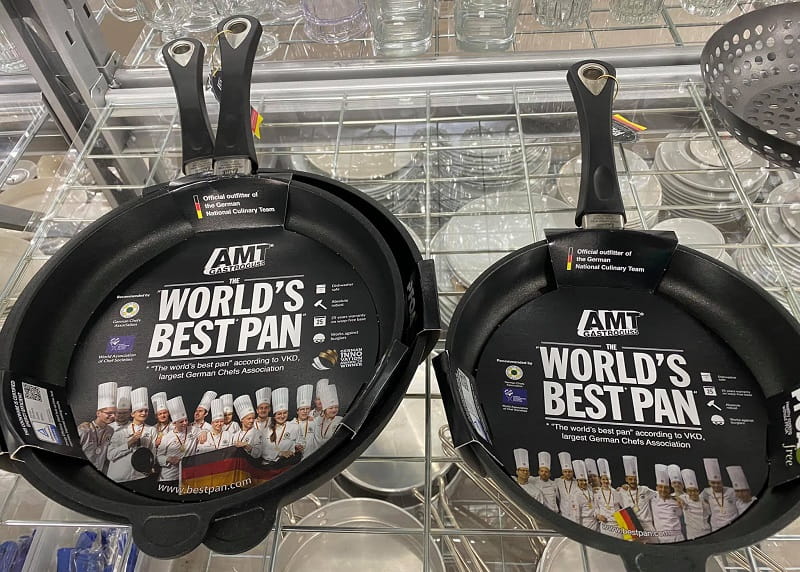When it comes to cooking, having the right tools in your kitchen is essential. For many home cooks, one of the most important cookware they’ll need is a frying pan or a sauté pan. But with so many different types and sizes available, deciding which is best for you can be tough. To help you make an informed decision, let’s look at the differences between a frying pan vs saute pan. We’ll examine their respective features, as well as their intended uses and benefits. By the end of this article, you should have all the information you need to choose the right cookware for your next recipe.
What is Frying Pan?

The frying pan is one of the most essential cookware pieces and is a kitchen staple. But what exactly is a frying pan, and why is it so important?
A frying pan is a flat-bottomed pan with sloping sides and a long handle designed for cooking food quickly and evenly over high heat. These pans can be made from various materials, including stainless steel, cast iron, copper, and non-stick coatings, each with unique benefits and drawbacks.
One of the key benefits of using a frying pan is its versatility. These pans can be used for everything from frying eggs and bacon to sautéing vegetables and searing steaks. With the ability to be used on the stovetop or in the oven, frying pans offer a range of cooking options to suit any meal.
But it’s not just about the cooking capabilities of a frying pan – it’s also about the quality of the food it produces. A good frying pan will distribute heat evenly across the cooking surface, ensuring your food is always perfectly cooked. And with the right seasoning and care, a frying pan can last for years, becoming a reliable and trusted tool in your kitchen.
Of course, choosing the right frying pan can be daunting with so many options on the market. It’s important to consider factors like the size and shape of the pan, the material it’s made from, and any special features it may have (like a non-stick coating or heat-resistant handle).
As someone who has used countless frying pans over the years, I can confidently say that investing in a high-quality pan is worth the cost. Not only will it last longer than a cheaper alternative, but it will also improve the quality of your cooking and make meal prep much more enjoyable.
What is Sauté Pan?

A sauté pan is a wide, shallow pan with straight sides and a long handle. It is typically made of stainless steel or cast iron, although non-stick versions of ceramic or hard-anodized aluminum can be found.
So why is a sauté pan so important? Its design allows for even heat distribution, crucial when cooking delicate foods like fish or vegetables. The wide surface area also makes it easy to cook in batches, which is ideal for recipes that require multiple steps.
As the name suggests, one of the most common uses for a sauté pan is sautéing. This involves cooking food quickly over high heat in a small amount of oil or butter. The shallow sides of the pan make it easy to stir and toss the food as it cooks, helping to ensure that it cooks evenly.
But sauté pans can also be used for cooking techniques, like frying. The wide surface area and straight sides make fry foods like chicken or fish easy, while the long handle keeps your hands safe from the heat.
Another great feature of sauté pans is that many come with lids, which makes them ideal for braising. Braising involves cooking food slowly in a small amount of liquid, and the lid helps to trap heat and moisture, resulting in tender, flavorful dishes.
When choosing a sauté pan, there are a few things to remember. First, consider the size. A 10-12 inch pan is a good all-purpose size for most home cooks. You’ll also want to think about the material – stainless steel is durable and easy to clean, while cast iron is great for searing and can easily go from stovetop to oven.
Frying Pan vs Saute Pan: What’re The Main Similarities

Both pans are incredibly versatile and can be used for a wide range of cooking tasks. They are designed to cook food at high temperatures, allowing for quick and even heat distribution. Additionally, frying pans and sauté pans come in various sizes and materials, giving you plenty of options. Both pans, whether pan-frying, sautéing, or searing, will do the job. So, if you’re looking for a pan that can handle all your cooking needs, you can’t go wrong with a frying pan or a sauté pan.
What Are The Main Differences Between Frying Pan vs Saute Pan?

When it comes to choosing between a frying pan and a sauté pan, the main difference lies in their shape. A frying pan, also known as a skillet, has curved or sloped sides and is typically used for dry heat cooking like pan frying, stir-frying, and sautéing. On the other hand, a sauté pan has straight sides and always comes with a lid, making it suitable for both dry heat cooking and liquid cooking methods like frying, braising, and poaching. The straight sides of a sauté pan provide a larger flat cooking surface compared to a skillet, offering more space for food.
While a skillet is excellent for high-heat searing and the chef toss technique, a sauté pan is more versatile for cooking with liquids or when a lid is needed. Ultimately, it’s a personal preference, but having both pans in your kitchen can add flexibility to your cooking options.
Surface Area And Size
A sauté pan has straight sides and a larger flat cooking surface compared to a frying pan of similar size. This means a sauté pan provides more cooking area, allowing me to cook larger quantities of food or fit more ingredients into the pan. On the other hand, a frying pan has sloped sides, making it easier to flip or stir-fry food.
Volume
With its sloped sides, a frying pan is ideal for dry heat cooking methods like pan frying, stir-frying, and sautéing with a small amount of oil. On the other hand, a sauté pan, with its straight sides and a lid, can be used for both dry heat and liquid cooking methods, such as frying, braising, and poaching.
Because of its larger capacity and straight sides, a sauté pan is better suited for tasks that require more liquid or a lid, such as simmering, braising, or reducing sauces. So, a sauté pan would be a good choice if you want a versatile option.
Read more:
Weight
A sauté pan is typically heavier than a frying pan due to its larger size and straight sides. This added weight can make it slightly more challenging to handle, especially for individuals with weaker arm strength. On the other hand, a frying pan is generally lighter and easier to maneuver. So, a frying pan might be your better option if you’re looking for a more lightweight and easier to use.
Cooking Method
A frying pan is great for frying foods like chicken or fish because it has sloping sides that allow easy flipping and turning. On the other hand, a sauté pan has straight sides, which makes it perfect for sautéing vegetables or cooking delicate dishes that require gentle tossing.
So, while both pans have unique uses, the shape of the pan plays a crucial role in determining which cooking method is more suitable.
Tossing Ability
A frying pan, with its small, sloping sides and no cover, is perfect for longer cooking and browning food. On the other hand, a sauté pan has vertical sides and a lid, making it ideal for quickly cooking food over high heat with very little oil or fat.
The vertical sides of a sauté pan allow for easy tossing and flipping of food, making it a great choice for sautéing. So, if you enjoy the art of sautéing and want to flip your food in the pan, a sauté pan would be the way to go.
Evaporation
Since sauté pans have straight sides, they hold more liquid and are less prone to splashing compared to frying pans. This means that sauté pans are great for dishes that require more liquid, like stews and sauces. On the other hand, frying pans with curved sides are better for tasks that involve quick evaporation, like browning and sautéing.
Evaporation
A sauté pan has a wide flat bottom and tall vertical sides, while a frying pan has sides that flare outward at an angle. The shape of the sauté pan allows for a larger cooking surface and higher volume, making it ideal for tasks like shallow-frying or braising. The straight sides also minimize splashing and allow for a tighter-fitting lid, reducing evaporation. On the other hand, a frying pan with sloped sides helps moisture evaporate more rapidly, making it more efficient for searing.
So, each pan has advantages depending on your cooking technique and dish. I prefer using a frying pan for sautéing as it allows me to shake the pan and ensure even cooking easily.
Lid
Depending on the manufacturer, frying pans may or may not come with a lid. On the other hand, sauté pans always come with a lid. The lid in a sauté pan is particularly useful for cooking methods that involve liquids, such as simmering, poaching, and braising. It helps to hold in the heat and prevent evaporation.
In contrast, frying pans are primarily designed for dry heat cooking methods like pan frying, stir-frying, and sautéing, where a lid is not always necessary. So, if you need a pan with a lid for liquid cooking methods, a sauté pan would be the better choice.
Sides
A frying pan, a skillet, typically has curved or sloped sides, while a sauté pan has straight sides. The straight sides of a sauté pan make it more suitable for braising, poaching, and cooking with liquids. On the other hand, the sloped sides of a frying pan make it ideal for pan-frying, stir-frying, and sautéing with a small amount of oil.
Heat Distribution
I’ve found that the shape and design of these pans greatly impact how evenly heat is distributed. Frying pans, with their slanted sides, allow for quick evaporation and are perfect for browning. They are great for tasks like pan-frying, stir-frying, and sautéing.
On the other hand, sauté pans have straight sides, which provide a larger flat cooking surface and allow for better heat distribution. This makes them ideal for liquid cooking methods like braising and poaching. Plus, sauté pans come with lids, which come in handy for simmering and reducing sauces.
High-Temperature Searing
A frying pan, or skillet, is shallow with curved or sloped sides. This design allows for quick evaporation, making it ideal for browning food. On the other hand, a sauté pan has straight sides and is typically deeper. It is better suited for cooking with liquids, such as braising or poaching, as it can hold more volume.
So, a skillet is your best bet if you want to achieve a nice sear on your steak or chicken. However, if you’re cooking with liquids or need a lid, a sauté pan is a more versatile choice.
Frying Pan vs Saute Pan: Maintenance

A frying pan, typically used for frying eggs or searing steaks, requires relatively less maintenance. It is designed with a nonstick surface, allowing easy food release and quick cleanup. Avoid using metal utensils that can scratch the surface to maintain their nonstick properties. Instead, use silicone, wooden, or plastic utensils. Additionally, handwashing is generally recommended for frying pans to prevent damage to the nonstick coating.
On the other hand, a sauté pan is a more versatile option, ideal for tasks such as browning, simmering, braising, and one-pot meals. Unlike a frying pan, sauté pans often come with a lid, making them suitable for longer cooking. Maintenance-wise, sauté pans usually require a bit more effort. They may need a thorough cleaning to remove lingering food particles or stains. It is best to use a non-abrasive sponge or cloth along with mild dish soap to clean the pan. While sauté pans are generally dishwasher safe, handwashing is recommended to preserve their quality and lifespan.
Frying pans with nonstick surfaces requires gentle handling and handwashing to protect the nonstick coating. In contrast, sauté pans may require more thorough cleaning due to their versatility and longer cooking times. Regardless of the type of pan, proper maintenance helps to ensure their longevity and optimal performance in the kitchen.
Cost
Generally, sauté pans tend to be more expensive than frying pans. This is mainly because sauté pans often come with a lid and straight sides, providing a larger cooking surface area. On the other hand, frying pans typically have sloped sides and are designed for tasks that do not require covering.
However, both pans can be used interchangeably for sautéing, pan frying, and high-heat searing tasks. So, if you’re on a budget and don’t need a lid or a larger cooking surface, a frying pan may be the more cost-effective option.
Handles
Frying pans typically have one long handle, while sauté pans often have two short handles. This makes a difference in how you handle the pans. With a frying pan, the long handle allows for a comfortable grip and easy maneuverability.
On the other hand, sauté pans with two short handles provide better stability and control when cooking with larger volumes or heavier ingredients. The additional handle also comes in handy when transferring the pan in and out of the oven.
So, when it comes to handles, it depends on your cooking style and preference. I like the convenience of a long handle for everyday use, but I also appreciate the added stability of the two short handles when dealing with larger dishes. Choosing a pan with handles that suit your needs and make cooking comfortable and enjoyable is important.
Advantages And Disadvantages of Using a Sauté Pan
Of course, like any piece of cookware, there are advantages and disadvantages to using a sauté pan. Today, I’ll share my experience and expertise on the topic, so you can decide whether a sauté pan is right for you.
Advantages of Using a Sauté Pan:
- Even Heating: One of the biggest advantages of using a sauté pan is that it distributes heat evenly across its surface. This means your food will cook more evenly, reducing the risk of hot or burnt spots.
- Versatility: Sauté pans come in various sizes and materials, so you can choose one that best suits your needs. Whether cooking for one or feeding a large family, a sauté pan out there will work for you.
- Easy to Use: Sauté pans are typically lightweight and easy to handle, making them an excellent choice for novice cooks or those with limited mobility.
- Quick Cooking: Because sauté pans heat up quickly and evenly, they’re a great choice for quick-cooking dishes like stir-fries or pan-seared meats.
Disadvantages of Using a Sauté Pan:
- Limited Capacity: Depending on the size of your sauté pan, you may find it’s not large enough to cook certain dishes. If you’re cooking for a crowd or making a large batch of soup or stew, you may need to use a larger pot.
- Not Ideal for Deep-Frying: Sauté pans are not designed for deep-frying, as they don’t have high enough sides to prevent oil from spattering out of the pan.
- Can be Tricky to Clean: Depending on the material of your sauté pan, it may be difficult to clean. For example, cast iron and stainless steel pans can be prone to food sticking and require more effort to clean than nonstick pans.
- Not Suitable for Certain Foods: Because sauté pans are designed to cook food quickly over high heat, they may not be suitable for dishes that require slow, gentle cooking, such as braises or stews.
Advantages And Disadvantages of Using a Fry Pan
Here are the advantages and disadvantages of using a frying pan from my point of view.
Advantages of Using a Fry Pan
- Versatility – A frying pan is a versatile tool that can be used for various cooking tasks. Whether you’re sautéing vegetables, frying eggs, or searing a steak, a frying pan can handle the job.
- Even Heat Distribution – A good quality fry pan will distribute heat evenly, so your food will cook evenly. This is essential for achieving the perfect sear on a steak or getting crispy fried chicken.
- Easy to Clean – Fry pans are typically easy to clean, especially using a non-stick pan. After cooking, clean the pan with a paper towel or rinse it with soap and water.
- Affordable – Fry pans are relatively affordable, especially compared to other cookware. You can find a good quality fry pan for under $50, which makes it a great option for home cooks on a budget.
Disadvantages of Using a Fry Pan
- Limited Capacity – Fry pans are typically smaller than other cookware, so you can only cook small batches at a time. This can be a disadvantage if you cook for a large family or host a dinner party.
- Not Ideal for Certain Foods – While a frying pan can handle various cooking tasks, it’s not ideal for every type of food. For example, you wouldn’t want to cook a pot roast in a frying pan, as it wouldn’t have enough space to cook properly.
- Can be Heavy – Some fry pans, especially made from cast iron, can be quite heavy. This can be a disadvantage if you have weak wrists or struggle lifting heavy objects.
- Can be Messy – Some oil will inevitably splatter when frying food in a pan. This can be messy and difficult to clean up, especially using a non-stick pan.
How To Choose The Best Fry Pan?
When choosing the best fry pan, there are two key factors: functionality and materials. As someone who loves cooking, I have learned that selecting the right fry pan can greatly improve the results of my culinary creations. The material your cookware is made from can significantly impact how your food turns out and how easy it is to clean up afterward. I have found that stainless steel tri-ply pans are the ideal choice for general cookware, as they are durable, versatile, and provide even heat distribution.
However, I would caution against tri-ply options when it comes to baking sheets, as they can be pricey and retain heat longer than bare aluminum. I prefer heavy-gauge aluminum sheets for baking, as they heat up quickly and evenly. Additionally, it is essential to choose a frying pan that suits your cooking style and preferences. Carbon steel pans are great for high-temperature cooking, while cast-iron frying pans are known for their versatility and ability to develop a smooth patina over time.
Ultimately, finding the best fry pan for you involves considering how you cook and what materials will help you achieve the best results.
How To Choose The Best Sauté Pan?
When choosing the best sauté pan for your kitchen, you should consider a few key factors.
- First, think about the material of the pan. Stainless steel pans are durable and distribute heat evenly, while nonstick pans are easy to clean and prevent food from sticking. Cast iron pans are long-lasting and provide excellent heat retention.
- Next, consider the size of the pan. A 3-quart pan is ideal for small families or individual meals, while a larger 6-quart pan is great for cooking in large batches.
- Additionally, look for a pan with a handle and lid for easy and versatile cooking.
- Finally, think about the maintenance and care of the pan. Some pans are dishwasher-safe, while others require handwashing.
These factors will help you find the perfect sauté pan that meets your needs and makes cooking a breeze.
Tips For Properly Maintaining And Cleaning These Types Of Pans?

I know the importance of having a well-maintained and clean frying pan or sauté pan. Over the years, I have learned some tips and tricks for properly maintaining and cleaning these pans, and I am excited to share them with you.
- First and foremost, using the right utensils when cooking with a frying pan or sauté pan is crucial. Metal utensils can scratch the pan’s surface, leading to food sticking. I always recommend using wooden or silicone utensils to avoid any damage.
- Next, it is essential to clean the pan after each use properly. I recommend using hot water and a soft sponge to clean the pan. Avoid using abrasive sponges or harsh chemicals, as they can damage the pan’s surface. If you need to use soap, rinse it off thoroughly, as any leftover soap can affect the taste of your food.
- For tougher stains or burnt-on food, try soaking the pan in hot water and a bit of dish soap for a few hours. This can help to loosen any debris, making it easier to clean. If you still have trouble getting rid of the stain, try using a bit of baking soda and water to create a paste. Apply the paste to the stain and let it sit for a few minutes before rinsing it.
- When storing your frying pan or sauté pan, it is best to avoid stacking them. Stacking can scratch the surface of the pan and cause damage. Instead, store your pans separately, either hanging them up or placing them in a cabinet with a protective layer between them.
- Finally, regularly seasoning your pans is important to keep them in top condition. Seasoning involves coating the surface of the pan with a layer of oil and heating it until it smokes. This helps to create a non-stick surface and prevent food from sticking to the pan.
Proper maintenance and cleaning of your frying pan or sauté pan is crucial for both the longevity of the pan and the taste of your food. By using the right utensils, cleaning the pan properly, storing it correctly, and seasoning it regularly, you can keep your pan in top condition for years.
Frying Pan vs Saute Pan – FAQs
Can A Frying Pan Be Used As A Sauté Pan And Vice Versa?

From my experience in the kitchen, I can confidently say that a frying pan can be used as a sauté pan and vice versa, but we should consider some differences.
- A frying pan typically has sloped sides and is shallow, making it perfect for quick evaporation and browning. It is great for frying, stir-frying, and pan-frying with a small amount of oil.
- On the other hand, a sauté pan has straight sides and is more profound, allowing for more liquid cooking and the use of a lid. It is ideal for braising, poaching, and simmering.
So, while you can use a frying pan for sautéing and a sauté pan for frying, each has its own strengths and is better suited for specific cooking methods. Personally, I like to have both in my kitchen, as it gives me.
Which Type Of Pan Is Best For Cooking Eggs? (note them A vs B de tool hieu dang noi ve sanr pham nao)
In my experience, a frying pan is a way to go. Fry pans are designed with a nonstick surface, making it easy to flip and slide the eggs out without sticking or breaking. The slightly sloped sides allow easy flipping and turning of omelets or fried eggs. Additionally, fry pans are usually lightweight and easy to maneuver, which is essential when working with delicate eggs.
What Type Of Pan Is Best For Searing Meats And Achieving A Crispy Exterior?
In my experience, I have found that a sauté pan is the best option. It should have a long sturdy handle, a flat bottom, and low sides. The material is also important – stainless steel is my go-to for a hot and fast sear on delicate foods like scallops or thin-skinned fish. The fast response to changes in heat gives me more control over the temperature.
As for the oil, I recommend using refined oil with a higher smoke point, such as canola, avocado, or grapeseed oil. This ensures the pan is hot enough to create that sizzling sound when the meat goes in. Too little oil can lead to sticking, while too much can result in a greasy outcome.
What Are The Advantages Of Using A Sauté Pan For Cooking Vegetables?
I love using a sauté pan for cooking vegetables! There are so many advantages to using this versatile pan. First of all, the straight sides and wide cooking surface of a sauté pan provide ample space for vegetables to be evenly cooked. The even heat distribution ensures the vegetables are cooked without hot or cold spots.
Additionally, the tall sides of the sauté pan help to contain the vegetables, preventing them from spilling out while stirring or tossing. The lid with the sauté pan also helps trap in the steam, allowing the vegetables to cook in their juices and retain their natural flavors and nutrients. Another advantage is that the sauté pan allows quick cooking, which helps preserve the vegetables’ vibrant colors and crisp textures.
Can A Sauté Pan Be Used For Deep Frying?
Yes, you can a sauté pan be used for deep frying. While deep-frying often requires a pot with high sides, a sauté pan can work well if you’re careful. The key is to avoid using a nonstick pan, as the high heat can release harmful chemicals. Instead, opt for stainless steel or enamel-coated cast iron. These materials can handle the heat and won’t discolor over time.
Just be prepared for splattering, and use a stainless steel strainer to fish out the deep-fried items. So, if you don’t want to splurge on a deep fryer, try your sauté pan for some delicious deep-fried treats!
Conclusion
In conclusion, frying and saute pans are essential tools in any kitchen. While they may look similar, they are designed for different types of cooking. Choosing a frying pan vs saute pan will ultimately depend on your preference and the cooking you plan. So, next time you’re in the market for a new pan, consider your cooking needs and choose the one that’s right for you.
References:
- https://www.tastingtable.com/1307486/tips-perfect-sear-steak/
- https://www.nytimes.com/wirecutter/blog/how-to-choose-the-right-pan/
- https://www.katom.com/learning-center/put-a-lid-on-it.html

Hey readers! Chip Holland here, and I’m a Manager of this website. My passion for writing about it only matches my passion for BBQ. Follow my blog for mouth-watering recipes, tips, and tricks for the perfect smoke, grill, and BBQ. I’m sure you won’t be disappointed!
